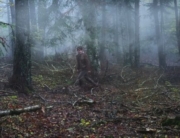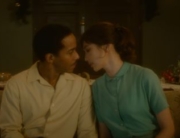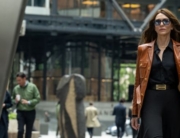Being stuck in a dwelling for a long period of time is now relatable to many across the country and the world. In Vasilis Katsoupis’s intriguing, but ponderous film, Willem Dafoe plays Nemo (the name which translates as “nobody” in Latin), an art thief who gets stuck in a sealed-off condominium high in the Manhattan skies after a heist goes awry.
The episodic, individualistic survivor tale takes on a lot. Even small details, like the malfunctioning central air unit in the apartment, oscillating between high heat and cold, evokes themes of climate change. The condo, full of contemporary art (the pieces and its artists are included in the credits), is almost like a heavily gilded storage space. It’s airtight, with a talking fridge that plays the “Macarena” when open too long—and sparsely filled with vodka and gourmet condiments. It’s almost as if Nemo is stuck in a spaceship, mirroring situations in Duncan Jones’s Moon or the vortex in Stanley Kubrick’s 2001: Space Odyssey.
In fact, Inside, sometimes feels like science fiction as it displays the overtly technological trappings of the apartment, including a robotic voice heard over the blaring alarm system. There is also the idea of the voyeur through surveillance as Nemo watches on a jittery television monitors images from around the building—mostly the banality of the front desk, the building’s gym, and a maid who we see in stairways and the elevator listening to music on her earbuds or sneaking a smoke. The irony is that these apparatuses created to protect and surveil are useless—as Nemo is so insulated and cut-off in this trap—so much so that no one can free him. Inside also feels like a throwback to lugubrious films of the early aughts, such as Cameron Crowe’s Vanilla Sky and Panic Room by David Fincher. Radiohead’s somber “Pyramid Song” figures—earnestly inserted to add to the solemn tone. Attracted to shadows, sleek surfaces, and the grim hearts of humankind, Katsoupis seems inspired by Fincher in particular.
Dafoe is a perfect choice for this vehicle, with his angular features and relentlessly charismatic oddness. As usual, he goes all in with his turn, including a sickly-looking physical transformation. When he starts dipping into the fish tank for water and for food, it’s squirm inducing. He is effectively filmed by Steven Annis (who shot the distinctive vaporwave-esque purple doom imagery in Richard Stanley’s Color Out of Space). Instead of rampant close-ups of Dafoe’s face and deep eyes, we see Nemo from above, behind, or below—the camera zooming in to pricks of sweat on the back of his neck, or his sallow, weakening legs—as if we are watching him within an exhibit or fractals of him in collage. Other aspects of the movie’s crafts—the art decoration and set design, as well as the sound work—create a potent atmosphere.
As the seasons shift, from fireworks to snowfall, Inside delves into the abyss of Nemo’s dreams and nightmares, as he furthers down a spiral—physically and mentally—talking and singing to himself, in makeshift protective eyewear (out of cloth and broken glass), desperately attempting to escape. A heavily symbolic and mythological-referenced story, filmed with attention to geometry and sharply edged shapes, the movie could be a parable for many things: depression, grief, the division between the patron and the artist, the renowned and the unknown, the animal and the human (“What side of the divide are you on?” someone asks in a dream sequence). The film is a bit too drawn out and bleak to be entertaining, and too heavy-handed and leaden to feel as thoughtful as it yearns to be, but it does offer an unnerving experience nevertheless.

















Leave A Comment